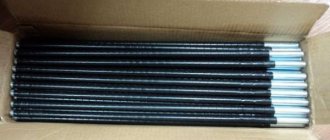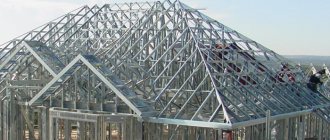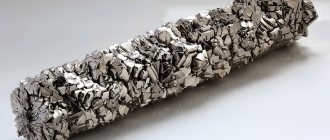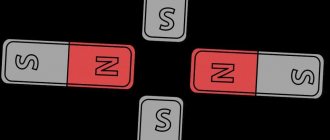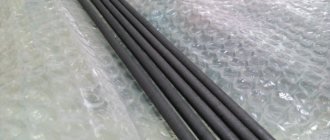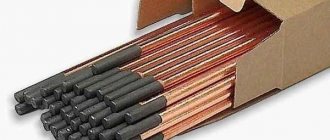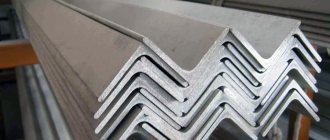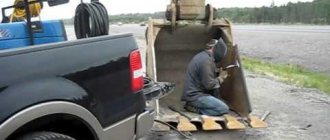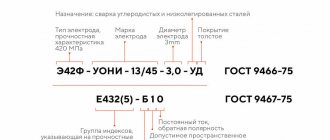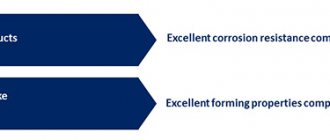The more carbon and other elements used to alloy and improve characteristics in steel, the more difficult it is to weld. The main elements contained in special electrodes EA 395 9 are nickel and chromium. They promote the melting and joining of alloy and stainless steels without stress in the transition zone and cracks in the seams.
EA 395 9 are used for manual electric arc welding of parts in highly critical structures operating in a wide temperature range. They are used to weld blades, rotor units, disks of steam and gas turbines, steam pipes and various parts of units operating in an alkaline environment and under water.
Scope of application of electrodes EA 395 9
The development of EA 395 9 electrodes was carried out purposefully. It was necessary to join by welding workpieces made of stainless steel, carbon and low-alloy steels with austenitic and pearlite structures that cannot be welded with standard electrodes UONI, OMM and others, or require lengthy preparation and normalization. They are used for welding:
Figure 1 — Electrodes EA 395 9
- metal structures made of alloyed rolled sheets operating in extreme cold conditions;
- units operating under variable load conditions;
- frames and bases made of austenitic steels of increased hardness;
- critical structures made of high-strength alloy steels;
- alloys of different compositions, including low-alloy and stainless steels;
- compounds of alloys with pearlitic and austenitic structure;
- loaded units made of medium-carbon, low-alloy steels and stainless steel;
- structures made of chromium-nickel steels, heat-resistant austenitic metals without niobium as an alloying substance and increased requirements for the degree of intercrystalline corrosion;
- facing of edges in preparation for welding of austenitic metal with pearlitic metal;
- When multi-layer surfacing of an anti-corrosion coating is applied, the first lower layer or all of them are deposited.
The mechanical properties of the resulting seam allow structures to operate at temperatures from -70⁰ to +580⁰ under conditions of vibration and dynamic loads.
Austenitic steels in the normal state have a structure with a predominance of austenite. This is the result of their chromium, nickel and manganese content. This class includes stainless and heat-resistant steels. When heated, the crystal lattice of austenitic steels does not change, and corrosion resistance increases.
The purpose of EA 395 9 electrodes is characterized by their unique ability to firmly and stress-free connect steels of the AK group, which are in demand in mechanical engineering, the energy industry, heating engineering, metallurgy and other industries due to their characteristics:
- high hardness;
- cold plasticity;
- corrosion resistance;
- good cutting performance;
- heat resistance.
The weldability of alloyed metals of the AK group is low. The technology of welding with standard electrodes is complex and time-consuming using hot-melt furnaces before and after weld deposition. When working in aggressive environments, a conventional seam quickly breaks down. The composition of EA 395 9 does not oxidize and does not interact with acids and alkalis.
Welding of stainless and alloy steels with electrodes of other brands is carried out with mandatory heating of the parts so that the metal does not crack from rapid local heating. Immediately upon completion of the work, a tempering is done to relieve stress in the transition zone of the seam and level the structure of the material.
Advantages
EA electrodes make it possible to connect parts made of different types of metals, which cannot always be done with other consumables, or require labor-intensive preliminary preparation. 395 9 electrodes, thanks to the unique components of the rod itself and its coating, allow the following complex work:
- Connect alloy sheet products for further use in extreme cold.
- Weld components that will be subject to variable loads.
- Participate in welding bases and frames that have increased hardness.
- Weld high-strength parts.
- Combine alloys of different compositions.
- Weld austenitic steels, in particular stainless and heat-resistant steels.
- Weld joints that are under increased load.
- Surfacing the first lower layer results in a more durable seam.
The quality of the resulting seam allows the products to operate at high temperatures and under significant loads. The seam is neat and even, metal spattering is minimal, and slag separation is easy. Welding can be carried out in all positions.
EA 395 electrodes have the unique ability to connect steels that are in demand in various fields and have the following characteristics:
- high hardness;
- plastic;
- increased resistance to corrosion;
- heat resistance.
The composition of these consumables is not prone to oxidation and does not interact with acids and alkalis. The weld metal does not have slag inclusions.
Characteristics and parameters
The electrodes are coated with potassium fluoride.
As a result, the seam has enough ferrite to prevent hot microcracks and tears from forming. After cooling and removing the slag, the result is a neat joint with high viscosity and ductility, capable of withstanding heavy loads and sudden temperature changes. The seam is strong and flexible. This is facilitated by the chemical composition of the deposited metal.
| Substance name | Element designation | Content in % |
| Nickel | Ni | 20-27 |
| Chromium | Cr | 13-15 |
| Molybdenum | Mo | 4,5-7 |
| Manganese | Mn | 1,2-2,7 |
| Carbon | C | ≤ 0,12 |
| Silicon | Si | 0,35-0,7 |
| Nitrogen | N2 | 0,08-0,2 |
| Phosphorus | P | ˂ 0,03 |
| Sulfur | S | ˂ 0,018 |
The potassium fluoride coating evenly covers the seam with slag and reduces the evaporation of alloying elements and iron, and uniform slow cooling occurs.
When surfacing 1000 g of metal, approximately 1600 g of electrodes are consumed. The consumption coefficient is correspondingly 11 g/Ah.
Characteristics
EA 395 9 electrodes have characteristics that ensure a high-quality and durable seam. A significant role in this is played by the coating, which is potassium fluoride. The result of this is the presence of a large amount of ferrite in the resulting weld. This prevents the formation of ruptures and hot microcracks. The connection has high strength, ductility and viscosity, which allows it to withstand loads and temperature changes.
The chemical composition of the surfacing is successful, in which the highest content is nickel, and then chromium. The coating covers the seam with slag evenly, which reduces the evaporation of elements and simultaneously promotes slow cooling.
Features of operation with electrodes EA 395 9
Thanks to the unique composition of the rod and coating of EA 395 9 electrodes, they differ from other brands in their positive welding characteristics:
- smooth and neat seam;
- minimal metal spattering;
- the slag is easily separated after cooling;
- welding is performed in all spatial positions;
- the seam is formed with a high coefficient of impact strength;
- a significant indicator of plasticity.
Figure 2 - Electrodes EA 395 9 from different manufacturers
When using EA 395 9, the peculiarity of welding is the ability to join steels of different grades and structures, to weld stainless steel, while internal microcracks do not form, the weld metal is clean without slag inclusions.
Cooking should be done with direct current of reverse polarity with a short arc. The electrode almost touches the edges without lateral movement. Parts at the junction must be cleaned of scale, rust, dirt to pure metal with a characteristic shine. Before use, the electrodes should be dried in an oven for 2 hours at a temperature of 200⁰-250⁰.
This allows you to apply a seam in any position except vertical in the direction from top to bottom. In the ceiling position, with a content above 0.12%, the seam may bubble with the formation of gas inclusions.
The current should be set depending on the diameter of the electrode and the position of the seam in space. The largest diameter of 5 mm can only be used horizontally. Verticals and ceilings are not suitable for them.
Welding of steels with austenitic crystal lattices is carried out after hardening, which increases the hardness of the material, its ductility, strength and refines the grain. Subsequent heat treatment to relieve stress in the weld area is not performed.
Features of the technology
Welding of parts with electrodes of this brand should be carried out using direct current. The polarity should be reversed. The arc should be short. It is necessary to pre-clean the edges of the surfaces to be welded from various contaminants, scale and traces of rust. A clean metal surface with a characteristic shine should be obtained.
Before starting work, calcination must be carried out for at least two hours at high temperature. Hardening will give a good result, which will increase ductility and hardness. It is not recommended to weld downward as this may cause blistering of the seam.
The magnitude of the current depends on the diameter of the selected type of electrodes and position in space. Of the three diameters available, the largest of them, which has a value of 5.0 millimeters, should be used only for a horizontal position. These consumables can be used for industrial welding and for home use.
Mechanical properties of weld metal
Welding seam EA 395 9 is characterized by high strength in a thermally strengthened state:
- tensile strength - 608 MPa;
- sample elongation to failure 30%;
- impact strength 120 J/cm2;
- tensile yield strength 392 MPa.
The unique properties of the weld metal allow welded structures to operate under conditions of variable loads and vibration.
The seam when welding with EA 395 9 electrodes is characterized by uniformity and strength. Microcracks do not form in it. Nickel provides stability when metal melts and joins. It is contained as an alloying element in steel and up to 25% in the electrode.
Electrodes of the EA brand are produced in accordance with GOST 10052-75 and comply with the regulatory requirements of ISO 3581. They are suitable for industrial and home welding with direct current.
If readers have information that is not included in the article, please share it. Feel free to also ask questions that arise on this topic.
Parameters and characteristics
The main technical characteristics of this brand include:
- presence of base coating;
- presence of diameters from 3 to 5 mm;
- Suitable for welding alloys with a high level of heat resistance and steel, which contains up to 35% nickel.
This type of arc is characterized by stable combustion and no spattering during soldering. You can work in any position. And, if you are experienced, then the quality of seam formation will be high.
The disadvantages of this conductor include a slag crust, which is difficult to separate, as well as a low corrosion threshold, as is the case with stainless steel. It is not recommended to sew a seam vertically from top to bottom.
When you use this brand, it is recommended to use DC current and reverse polarity.
In addition to the above recommendations, it is necessary to take into account certain points when working with the EA-395/9 electrode even before starting work.
- First, you need to use the shortest arc possible. Usually, with this method, the master does not see very well how the scar comes together. And, if you are not yet experienced, it will not be easy for you, therefore, first practice on a spare or not entirely necessary workpiece.
- Secondly, in order for the seam to fit perfectly, do not forget to clean the surface of all parts. It is necessary that the places you will weld are free of corrosion, traces of paint or oil, as well as dust and dirt. You can clean it all using a grinder, sandpaper, file or grinder. So, you will definitely achieve the perfect result.
- And thirdly, it is very important to calcine the EA-395/9 electrode in a furnace before carrying out welding work. Calcination (drying) is recommended to be carried out at a temperature of no more than 330 C0 for 40-60 minutes. So, if you set the minimum degree, then the drying time should be at least an hour, and vice versa - the higher the temperature, the less it costs to pierce the rod.
Features of application
Before welding, it is necessary to take into account several characteristic features in order to obtain seams of decent quality. First of all, you need to cook with a very short arc. This is not easy if you are a beginner welder, but sooner or later you will still have to learn. With this welding method, it is difficult to see how the seam is formed. Therefore, before carrying out work, practice on an unnecessary workpiece in order to “get your hand” a little.
Don't forget about the details themselves. They need to be cleaned to a shine. The surface should be free of traces of dirt, dust, oil, paint, corrosion, etc. Cleaning can be done using any tool: a grinder, grinder, sandpaper, file, etc. Only with a clean surface will the electrodes reveal their potential.


